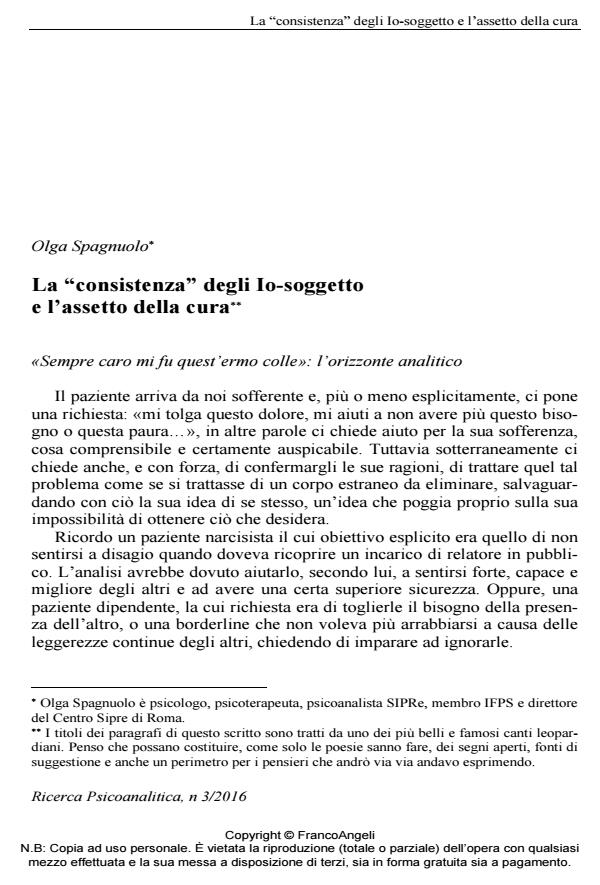The "consistency" of subjects-ego and the therapeutic set-up
Journal title RICERCA PSICOANALITICA
Author/s Olga Spagnuolo
Publishing Year 2016 Issue 2016/3 Language Italian
Pages 10 P. 57-66 File size 172 KB
DOI 10.3280/RPR2016-003005
DOI is like a bar code for intellectual property: to have more infomation
click here
Below, you can see the article first page
If you want to buy this article in PDF format, you can do it, following the instructions to buy download credits

FrancoAngeli is member of Publishers International Linking Association, Inc (PILA), a not-for-profit association which run the CrossRef service enabling links to and from online scholarly content.
What are the aims of psychoanalytical therapy? We certainly want to reduce the patient’s distress and we need to accept his/her specific way of conceiving it. Maybe be our main objective is to help the patient see, or better feel, how his/her problem is the outcome of a dysfunctional solution and in this way we can provide a way to change something. But a second parallel aim has in my opinion just as much importance. This disregards the "dynamic" (although it is strictly linked to it) that determines and renews repetition in order to feel the "consistency" of being, one’s "weight" in the world, to know that one is a unique and peculiar part, a live subject that "is" what he/she is or better that "is" just because he/she is what it is. We therefore aim to a presence that is intimacy with the world, that is deep participation and, starting from the recognition and legitimation of one’s whole subjectuality, embodies it wholly in the world.
Keywords: Subject-ego, subjectuality, therapeutic aims, consistency of being, psychoanalysis and literature
- Agostino. Confessioni. Bur, Biblioteca univ. Rizzoli, 2006.
- Baranger W. e M. (1961). Trad. it.: La situazione analitica come campo bipersonal. Milano: Raffaello Cortina Editore, 1990.
- Bion W. (1962). Trad. it.: Apprendere dall’esperienza. Roma: Armando, 1972.
- Bucci W. (1997). Trad. it.: Psicoanalisi e scienza cognitiva. Roma: Fioriti, 1999.
- Ceruti M. (2009). Il vincolo e la possibilità Milano: Cortina
- Freud S. (1912). OSF, vol IV. Torino: Boringhieri.
- Freud S. (1914). OSF, vol VI. Torino: Boringhieri.
- Julienne F. (2014). Trad. it.: Sull’intimità: lontano dal frastuono dell’amore. Milano: Raffaello Cortina Editore.
- Leopardi G. L’infinito. In: Canti. Milano: La Feltrinelli, 2008.
- Little M. (1951). Trad. it.: Il controtransfert e la risposta del paziente. In: Albarella e Donadio, a cura di, Studi sul controtransfert. Napoli: Liguori, 1998.
- Minolli M. (2009). Psicoanalisi della relazione. Milano: FrancoAngeli.
- Morin E. (2011). Trad. it.: La sfida della complessità. Firenze: Le lettere.
- Pasolini PP. (1957). Il pianto della scavatrice, In: Le ceneri di Gramsci. Milano: Garzanti.
- Racker H. (1968). Trad. it.: Studi sulla tecnica psicoanalitica Roma: Armando, 1970.
- Searles H. (1965). Trad. it.: Scritti sulla schizofrenia. Torino: Boringhieri, 1974.
- Szymborska W. (1945-2009). Trad. it.: Niente è in regalo. In: La gioia di scrivere. Milano: Adelphi.
- Turillazzi Manfredi S. (1994). Le certezze perdute della psicoanalisi clinica. Milano: Raffaello Cortina Editore.
- Weil S. (1943). Trad. it.: La persona e il sacro. Milano: Adelphi, 2012.
Olga Spagnuolo, La "consistenza" degli Io-soggetto e l’assetto della cura in "RICERCA PSICOANALITICA" 3/2016, pp 57-66, DOI: 10.3280/RPR2016-003005